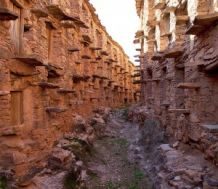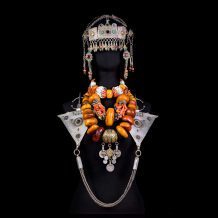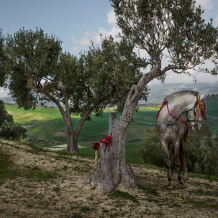The Seven Saints of Marrakech
Marrakech is Morocco’s leading culture capital and touted as the glorious “rose city.” Many also refer to it as the City of Seven Saint as it is home to the historic tombs of these seven figures of holy significance. Travelers are familiar with exploring Marrakech’s UNESCO world heritage medina, yet most stroll by the seven tombs unaware of this sacred site. Marrakech honors the Seven Saints in a specific location which is the region of Bab Doukalla. Just outside the medina wall, seven towers stand in a row, without signage to indicate their holy resting place. Their actual tombs, however, are spread throughout Marrakech.

Moroccan traditional beliefs hold superstition and often within these norms saints and spirits play an important role. Most religions see saints as holy figures however Moroccans interpret saints differently.
Contrary to popular belief, the Seven Saints are not from Marrakech. During the 17th century, the Kingdom collected remains found throughout Morocco and placed them in sacred sites around the city. The seven gravestones have become an important destination. There is even a suggested order for which saints should be visited first that corresponds with the days of each week. Tuesday is the day of the week that one must be to make a pilgrimage to The Seven Saint. Given each saint corresponds with answering a different prayer (illness, fertility, financial success, education), it is also popular to visit the saint that speaks directly to your interests.
In Morocco, saints do not need to originate from a notable church or be well educated. Historically, those who walked the countryside, regardless of their social status, provided medicine to the poor and performed acts of goodness were considered saintly. Those who were recognized as figureheads played a spiritual role often settling political and local disputes against tribal chiefs and acting as a substitute for prophets.
Some saints were able to travel to Andalusia and other Muslim countries with the goal to obtain a good education. After their deeds were considered complete, most saints returned to an isolated holy life within a Sufi community. Throughout Morocco, there are many holy places where travelers can go to celebrate various saints and pray to receive their blessings.
The Seven Saints reside in various locations throughout the city of Marrakech.
The Seven Saints reside in various locations throughout the city of Marrakech. Their gravestones can be visiting in a 3-4 hour timeframe and only Muslims can enter holy sights. The mosques and saint grounds are fascinating on their own and can be visited by non-Muslims.
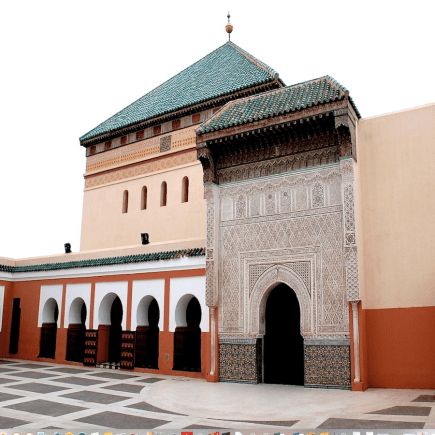
The Seven Saints Locations in Marrakech
#1: Saint Sidi Youssef Ben Ali (Tuesday)
Ben Ali was born in Marrakech and became famous within the community for defying death. He developed leprosy at an early age and was shunned by both his family and the community. During the 12thcentury leprosy was misunderstood. The locals thought that the disease was contagious and that they would also lose their limbs. Ben Ali was exiled and as a result, he moved to a cave near Bab Ghmat. The saint lived there until his death in 1196. His dwelling inspired his nickname “The Cave Man” or “Moul L Ghar.” After living beyond his expected age, he gained respect and was portrayed as a healer immune to both disease and poverty. While he was alive, Moroccans would travel from all corners of the kingdom to have their prayers answered. This tradition continues today.
Location: The cave is located on the outskirts of the Marrakech medina, near the Bab Ghmat Cemetery and the Oued Issil River.
Address: Av Bahmad Toulat, Marrakech
#2: Saint Qadi Ayyad Ibn Musa (Wednesday)
Ayyad ibn Musa was born and raised in the northern city of Ceuta during the Islamic Golden Age in 1149. Ceuta hosted many scholars from Andalucia, the wider Islamic community, and the Maghrib during this period. Today Ceuta is considered an official part of Spain.
Ibn Musa was influenced by many intellectuals who traveled to Ceuta and he then became a notary scholar. In 1113 and 1114, Ibn Musa traveled to Cordoba, Murcia, Almeria, and Granda where he met and studied with some of the most important scholars of the time. These figures included Abu Ali al-Ṣadafi (1120), Ibn al-Hajj (1134), Ibn Rushd (1126), and Ibn Hamdin (1114). From 1121-1136, Ibn Musa was appointed the judge of Ceuta. He also served as a judge in Granda, Spain. He led a revolt against the Almohades and as a result, he was banished to Tadla and then to Marrakech. Ibn Musa is considered the most scholarly of the seven saints. The University of Marrakech (Cadi Ayyad University) is named after him and referred to in his honor Saint Ibn Musa. He died in 1149 by a spear. He was executed for refusing to support the idea of Ibn Hazm and the Almohads, supporters of the Zahirite school of Sunni Islam.
Location: He is buried near Bab Ailen Pharmacy
Address: Rue de Bab Aylan, Marrakech
#3: Sidi Bel Abbas (Thursday)
Considered the patron saint of Marrakech and arguably the most important, Sidi Bel Abba is best recognized as distributing food to the poor and helping the blind. He was brought up in Ceuta during the 12th century. His father passed during Abbas’ teenage years. It is said that death inspired the saint to become absorbed in a world of books and studying. To help support the family’s finances, he was asked by his mother to work. It wasn’t until a Sheikh saw the young Abbas’ potential that he was permitted to spend time at formal study in the mosque. He learned under Sheikh Abi Abdellah Mohamed Lfakhar. Abbas’ zaouia is decorated with stucco. Its interior has a courtyard with a fountain. He died in 1204.
Location: He is buried at Sidi Marouk cemetery near Bab Tagzhout. Opening hours: Open daily from 8:30 to 11:45 and from 2:30 to 5: 45. Closed for religious holidays.
Address: Diour Jdad, Marrakech, Morocco
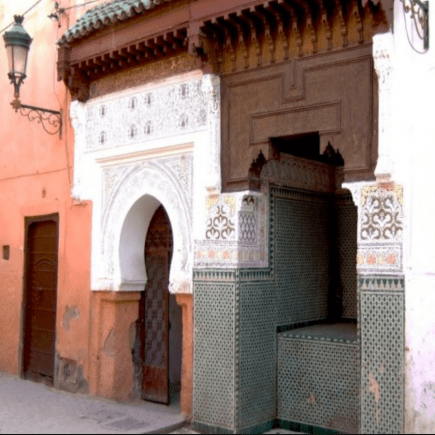
#4: Sidi Ben Slimane (Friday) Sidi Ben Slimane is known throughout the Islamic world for publishing his prayer book during the 15th century. The book has a description of prayers for each day of the week. Slimane was originally from the Souss Massa Draa region, near the coastal city Agadir. He became a well-liked Sufi leader of the Jazulah Berber tribe in Essaouira. Although it is rumored that he is a descendant of Ali ibn Abi Talib, the cousin and son-in-law of Muhammad, he was described as being down to earth. He experienced a sudden death while he was praying at the age of 75 (June 1465). He was originally buried in Essaouira.
Location: His tomb can be found near Riad Laarous in the northern part of the Medina.
Address: 46 Angle Derb El Gueza Et Derb Jamaa
#5: Sidi Abdel Aziz Tebbaa (Saturday)
Born with the name Abu Faris Abdelaziz Ben Abdelhaq Al Marrakchi, he held a career as a silk merchant. His profession is from where he received his nickname, El Harrar. Tebbaa not born to a wealthy or prominent family. In spite of this, he was able to study under Sidi Mohamed Ben Slimane Al Jazouli.
Jazouli’s tariqa (teaching) was followed by many Moroccans. The leader came to respect Tebba, eventually calling him the “Alchemist.” Tebba also learned from Al Jazouli, a major leader of the Tariqa Jazoulia Chadilia. From 1466, Tebbaa moved to Fes where he spent the next 8 years in the service of Sheikh Mohamed Sghir Souhaili. Upon returning to Marrakech, he built the zaouia in which he is buried today. Located in Hay El Qebbabin (Nejjarin), the sacred site brought together saints and scholars. The zaouia is visited today by people in search of miracles who wish for help with skin diseases, eye diseases, syphilis, or baldness. Women who visit the tomb perform a special ritual after praying. They bring locks that they use to close a window. The locks are not opened until their wishes have been granted. Tebbaawas considered a bridge between the two Sufi sects and also played a role in the development of science and Islamic mysticism.
Location: Tebbaa is buried near the Ben Youssef Mosque in the El Mouassine district of the medina. Zellige tiles typical of Fes, a traditional arched entrance, and wooden eaves characterize the sacred site’s exterior.
Address: D.El Maâden, Marrakech
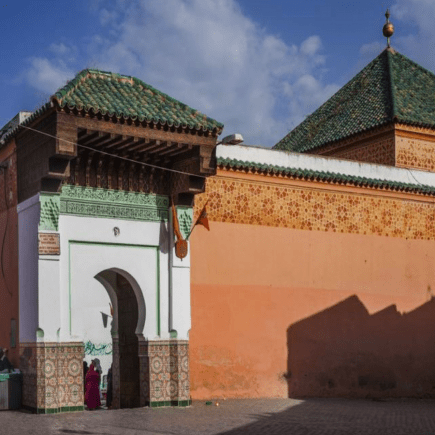
#6: Sidi Abdullah Ghazouani (Sunday)
Sidi Abdullah Ghazouani is a 16th-Century Sufi saint from Fes who is credited for writing the idea of the Tariqa Muhammadiyya (associated with neo-Sufism) and known for his tendency to shake up the Moroccan monarchy. Sidi Abdullah preached the ideas of Ibn Arabi and Al-Jili. He spoke of the importance of both Islam and saints in society. After studying in Fes, Granada, and Marrakech, his opinions became more compelling to the public.
Ghazouani’s increasing power became a threat to the monarchy. Sultan Sidi Mohamed Cheikh imprisoned him. He remained incarnated until he was set free by Sultan Watasi. Watasi built him the Zaouia in Fes with the goal to isolate him. Ghazouani rebelled and returned to Marrakech where he built a zaouia in the neighborhood El Ksour. The saint is originally from the Gazouane tribe and nicknamed Moul El Ksour. Ghazouani also specialized in constructing channels and sinking wells. He died in 1528 and is buried near the Mouassine Mosque. He is known also for his poignant disagreements with the Marinid sultan for having predicted the end of the dynasty.
Location: His tomb is close to the Moussaine Mosque, not far from Jemaa-el-Fna.
Address: Lamouassine Derb Azouz N°11 Bis, Marrakech
#7: Imam Abderahim Souhaili (Monday)
A well-respected 12th-Century figure from the Spanish coastal town Malaga. Despite coming from a secular family and growing up in a period of censorship, he was considered open-minded and simple in nature. Souhaili was born with the challenge of being blind, however, came from a good family. They were poor but well educated. As a result, Souhaili accomplished things like becoming an expert in the law, memorizing the Quran, and being fluent in Arabic. Spanish was the saint’s native language. Many students studying legal matters follow him and pray to him for help with exams.
Location: His tomb is located on the outside of the wall, close to Bab Agnou, near the Saadian Tombs and Bab Rob cemetery
Address: Rue de La Kasbah, Marrakech
Suggested Etiquette When Visiting the Seven Saints:
There are particular traditions and etiquette that Muslims follow when visiting the sacred sites of the Seven Saints. Among these is greeting the mosque by performing two prayers, then visiting the grave of the khalifah (successor) first and afterward the wali, observing the grave from outside, performing additional prayers, and presenting gifts.


